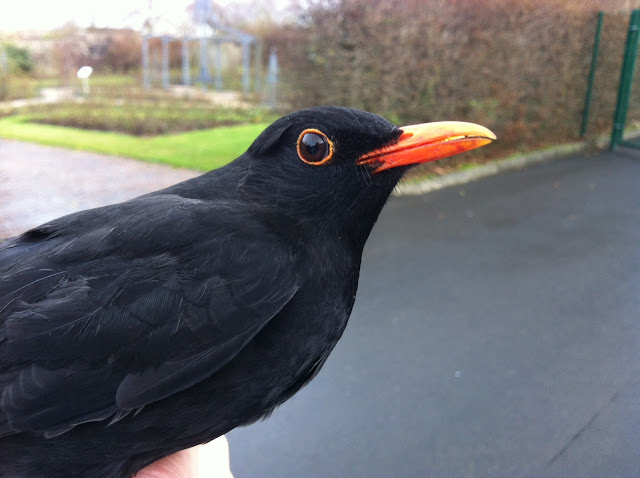Last Sunday John and I headed up to Antrim to host the second Copeland Bird Observatory ringing training event of the winter. We were very short on numbers with just ourselves so we were limited to 3 trainees. We arrived on site for 9am and put up 5 nets in the usual spots in what were very ideal conditions, if perhaps a little mild (but we can't complain about that in December).
We were once again amazed by the masses of Blackbirds spread throughout the site, which surely topped the 100 mark and no doubt many more. The nets in the mini orchard started to produce the goods at once and through the morning we had caught an impressive 21 new Blackbirds and a retrap from the previous winter. Redwings were numerous on the site but only a single bird was caught. The remaining flock of c70 birds were busy feeding on a tall Contoneaster trees with c20 Blackbirds and c30 Chaffinches, well away from the nets.
Blackbird
We again tried a single net in the wild bird cover field which has now been cut but there were still c40 Linnets around and plenty of seeds. The net proved unproductive with just a single Chaffinch and Linnet caught. The estate manager had let us know that the feeders have been relatively quiet over the past few weeks in the calm mild weather and this was again the case today, catching only c20 birds. All in all it was a good small session and the highlight was the exceptional catch of Blackbirds, that, with any luck, will produce some recoveries when they disperse.
Antrim Ringing Totals 18/12/2016
New Retrap
Blackbird 21 1
Blue Tit 4 2
Coal Tit 2 1
Chaffinch 9
Dunnock 1
Great Tit 6 3
Redwing 1
Robin 1
Wren 1
Total 46 7
Coal Tit
There is still a huge quantity of fruit, seeds and berries all across the site so it should continue to produce the birds during the next three visits in January, February and March. It would be a Waxwing paradise if they can just happen to stumble across it!
Back on the 5th of December Ken did a bit of garden ringing with Tyrone and had a great catch with over 100 birds processed of 13 species. The nets were opened at 08.30 in fine conditions and they finished up around lunch time. Chaffinches were the most numerous species caught with 30 birds processed. There was another new Treecreeper which are always a fantastic little bird to catch.
The numbers should continue to swell as winter takes grip and the plentiful wild food begins to deplete. We plan to have our traditional ringing session in Kens garden over the festive period, if the weather allows it, for a good catch up and a final few birds for the year.
Dunnock (JC)
Kens Garden 05/12/2016
Processed
Blackbird 1
Blue Tit 24
Bullfinch 1
Chaffinch 30
Coal Tit 10
Dunnock 2
Goldfinch 4
Great Tit 17
Greenfinch 1
Long-tailed Tit 3
Robin 6
Treecreeper 1
Wren 1
Total 101
On Saturday the 10th I had been down around the estuary 'working the patch' and visited Castlerock to see what was about. The scrub was humming with lots of Blackbirds, Song Thrushes and c15 Fieldfare. The other birds seemed to be roving in large flocks together with Bullfinch, Chaffinch, Greenfinch, Blue Tit and Reed Bunting. It was surely a missed opportunity for ringing but it looked too cold out the window first thing so I stayed in bed!
Fieldfare
The following day John and I went for an early morning visit to the scrub in cold and fairly breezy conditions and invited along David who was interested to see bird ringing in action . The plentiful thrushes were very noticeable around first light as they chacked and chattered and the first bird in the nets was only our second Fieldfare on the North Coast in the past 5 years. We picked up a few more birds in the first couple of hours including 3 more Song Thrushes but the wind got up and things went very quiet. The total of 11 new birds was very low considering the big numbers present but they should hopefully hang around for a few months yet. David was still very impressed and loved the opportunity of seeing the birds at close quarters.
Castlerock Golf Club 11/12/2016
New Retrap
Blackbird 1
Chaffinch 2
Dunnock 2
Fieldfare 1
Greenfinch 1
Robin 1 1
Song Thrush 3
Total 11 1
Greenfinch
Like the other side of the estuary at Portstewart Strand, the NI Environment Agency will be moving in to remove the invasive Sea Buckthorn across the area, although we think our ringing area will be spared the chainsaw. We are supportive of such habitat management but are hopeful the birds will be left a few small areas to breed and feed in winter.
We wish you all a Merry Christmas and a Happy New Year and we will back at that start of January with an update of our recent activities (if the weather allows it) and the final totals for the year.









































